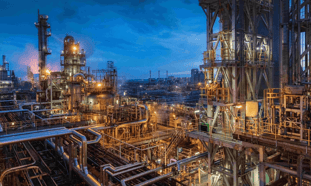Oil & Gas industry – Offshore services
Offshore drilling for oil began in the Caspian Sea in Baku, Azerbaijan in the late 1890s and about the same time at Summerfield in California, H.L. Williams decided to build a wharf off the beach in the Pacific Ocean on which he could erect a drilling rig.
At that time little guidance was available from geological research and the decision to go ‘offshore’ was inspired rather by observation that wells nearest the water seemed to deliver the best production rate. True ‘offshore’ oil production is believed to have started in Bibi Heybat Bay in 1924.
Many years later, as production from land-based deposits began to decline and assisted by sophisticated 2 and 3 dimensional displays of seismic data, offshore oil and gas production has now been established in many locations.
Most notably these include the North Sea, the Gulf of Mexico, the Campos and Santos Basins off the Brazilian coasts, Newfoundland and Nova Scotia, the West African coasts of Nigeria and Angola and offshore fields in south-East Asia. The Barents Sea meanwhile, is expected to become a major future field.
Typical offshore operations
The popular image of offshore work often centres on a muddy drill floor, where wells are drilled to target the reservoirs of oil and gas below the surface – but this is only the beginning of the story.
According to oilcareers.com, the top end of each production well sprouts a branching series of pipes, gauges and valves called the ‘Christmas tree’. At this point, crude oil is a hot, frothy, corrosive, high-pressure fluid containing gas, water and sand.
After separation, the crude oil is then metered and pumped into the pipeline, or stored until sent ashore by tanker.
The gas separated from the oil may be used for fuel, or compressed and piped to shore or re-injected into the reservoir. Any gas that cannot be used is burnt in the platform’s flare; and very little gas is now flared.
Processing systems for the gas fields of the southern North Sea are relatively simple. The gas liquids are removed and then the gas is compressed, cooled, dehydrated and metered before being piped to shore.
All production and drilling systems have to be monitored constantly for leaks, since oil and gas are hazardous and extremely flammable.
Types of offshore oil platforms
The first oil platform in the world was built in 1947. The Oil Rocks platform was built 25 miles off the coast of Azerbaijan in the Caspian Sea and serves as a functional city with a population of 5000 people.
There are over 100 miles of paved streets on this, known to be the world’s largest oil platform. There are shops, restaurants, and even a library, with all workers living and working together, while this engineering marvel has been in existence for 60 years. There are of course, many different types of such platforms.
Robert Jent, President of Triple Diamond Energy, explains the difference between the different types of offshore oil platforms, “The continuous need for oil in all parts of the world has motivated the development of new ways to discover and obtain it. Because large supplies of oil are often found offshore, in oceans and lakes where fault lines and specific rock formations occur, oil companies and their engineers have pioneered new ways of drilling by developing many different types of offshore oil rigs.”
“There are basically three types of offshore platforms that have developed over the years. Concrete platform types have concrete legs made on land and towed out to sea by tugboats and once in place, extend all the way to the sea floor; the platform is then simply mounted atop them. Jack-up platform types have a concrete foundation on the ocean floor but sit atop metal legs that can often telescope and retract as the surface of the sea rises and falls, depending on the season and weather patterns.”
“The last type of oil platform actually floats and is held in place by enormous sea anchors that rest on the ocean floor. These floating platforms are the largest movable structures on Earth. The Petronius platform, an oil and gas platform in the Gulf of Mexico, depending on criteria could be considered the world’s tallest structure, standing 2000 feet above the floor of the ocean. It is partially a floating structure, so the title still rests safely with more typical earthbound structures such as the Petronas Towers in Malaysia.”
“The drilling for oil on these rigs,” Jent notes, “works much the same as their land-based cousins. The largest difference between the two is the offshore rig must find a place to store the oil when it is released. The Hibernia platform, an oil and gas platform off the coast of Newfoundland, stores its precious crude in large storage tanks that fill the empty space underneath the floating oil production island. These tanks are housed beneath along with ballast to help the 1.2 million ton island stay aright.”
Unique offshore challenges
The need to operate manned facilities offshore has presented some of the biggest challenges faced by the oil and gas industry and also unfortunately resulted in the biggest catastrophes, like the destruction of the Piper Alfa production platform in 1988 that resulted in 167 deaths.
Oil and gas offshore installations are industrial towns at sea, carrying the personnel and equipment needed to access reservoirs thousands of feet below the seabed, and maintain continuous hydrocarbon production. The most important functions are drilling, preparing water or gas for injection into the reservoir, processing the oil and gas before sending it ashore, and cleaning the produced water for disposal into the sea.
Manned facilities must remain above sea-level in all conditions. Enormous constructions like the Troll A platform have been built that stand with their feet fixed to the ocean floor. Other floating platforms that float in the water and are only anchored to the bottom of the sea are less expensive to build, but require additional security measures. Both types suffer from high bottom-hole pressure caused by the long fluid column between seabed and platform and high energy costs for pumping sand and cuttings up to the platform for separation.
Increasingly production is being located on the sea floor and operated remotely from land-based control centres.
Manned facilities also require intensive logistical support. Providing accommodation for thousands of skilled workers offshore demands a range of support services like catering, sanitation, medical care and human resource management that are very expensive to provide, because they depend on transport by ship and helicopter. Offshore employees also earn significantly higher wages and enjoy longer leave benefits. The increased use on sub-sea facilities reduces the numbers of workers required offshore.
... to continue reading you must be subscribed









